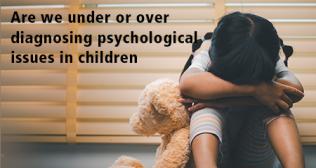
International Day of Innocent Children - Victims of Aggression

The surmounting rate of growing aggression is an infamously popular trend being spoken about. Such an increasing prevalence of aggressive tendencies today serves as an impetus to speculate on the consequences of such incidents on the children and adolescents’ physical, social, as well as emotional well-being. This could include all manifestations of aggression, whether as a victim, a perpetrator or a witness. It is shocking to note the gaining prevalence of such violence, especially towards children and adolescents in the recent past, be it behaviours like bullying, ragging, physical or sexual harassment.
Aggression in the society
Manifestations of aggression threaten not only young people's well-being, but can also result in physical injuries, social and emotional difficulties, and academic problems. Further, this is a potential consequence not just for the victims but for the perpetrators of the aggressive behavior as well. And then aggressive actions breed more such aggressive reactions, thereby creating a vicious cycle. As the victim of the aggressive act feels threatened, he or she is likely to engage in a reactive aggression. This furthermore leads to an added perpetuation of increasing instances of violence between the perpetrators and the victims. Not to ignore the role of the bystanders, who often tend to witness such acts but rarely are willing to step in to stop the perpetrator, or even report such instances, avoiding further embroilment. This is a sad but harsh reality
Understanding its impact on the victims
Aggression directed towards young children and adolescents can have a more devastating impact on their psychological well-being, in addition to harming their physical health, besides increasing their vulnerability towards mental illnesses, serious injuries or even death. Extensive research has shown that the perpetrators, victims as well as bystanders to aggressive behaviours are at a greater risk for psychiatric disorders in their early years, which can percolate into adulthood. Such problems can have lasting effects, especially if untreated. Examples of certain mental illnesses associated with such violence and aggression amongst the youth could include anxiety, depression, antisocial personality, substance abuse disorders, and post-traumatic stress disorders.
Further, it’s important to try and understand the psychological impact of such aggression within the child’s mind. Being a victim of aggression at any age is a very distressing experience, and more so for a child who is unable to comprehend the nature of the behaviour, nor does he or she developed the ability to adequately identify and verbalize his or her emotions appropriately in order to reach out or report the incident. Such an experience is capable of leaving a scar on the child’s psyche for a long-term basis, which could be in the form of a low self-esteem, lack of assertiveness, lack of confidence, distorted self-image, feelings of helplessness and lack of control, apprehensiveness, insecurity, social withdrawal, etc. In addition, it could also increase the child’s susceptibility to severe mental illnesses, thereby impacting their functioning and well-being in the future.
Need of a Preventive Approach
A holistic approach towards prevention of such aggression within the society needs to be targeted at various levels. Especially to focus on safeguarding innocent children, schools could promote awareness related to issues of violence amongst the children and adolescents, while developing anti-bullying and anti-violence rules and policies to be followed by the students, teachers, parents and all concerned authorities alike.
The incidents of violence can largely be prevented by teaching emotional awareness and management to children and adolescents, as they are allowed to explore their feelings, identify and label them appropriately, and look at alternative and less destructive means of expressing themselves. As we suppress our emotions, especially those of anger or frustration, these feelings tend to fester within us, thereby leading to an emotional outburst which then goes out of our control. Therefore, it is beneficial to encourage the youth to engage in activities like sports, dances, arts, theatre, writing, or other creative sources of venting their emotions regularly.
Working at both ends of the continuum, efforts should be made to train the children and adolescents in looking at the other side of things as well. It is necessary for them to be able to understand the experiences from the other person’s point of view, in order to fully understand the extent of the impact of such violent behaviours. Parental participation is an integral part of successful prevention towards aggression amongst the youth. They should be trained in employing practical strategies for deferring aggressive behaviour in the home settings, to bring an alignment with the policies being implemented by the school or colleges as well.
Categories
Clear allMeet the doctor

- Mental Health and Behavioural Sciences | Mental Health and Behavioural Sciences | Psychiatry | Clinical Psychology
-
21 Years
-
900



















